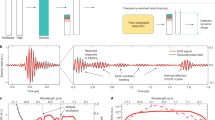Abstract
IN spectroscopic literature there are many casual references to a continuous background in the vacuum tube spectra of various gases, such as oxygen, chlorine, etc. Usually these observations appear to have been confined to the visible region, and I can recall no comments on continuous spectra in the ultraviolet except in the case of hydrogen. Schniederjost (Zt. f. Wiss. Phot., 1904, p. 265) and Friederichs (Bonn Diss., 1905) observed such a spectrum at low pressures, which extended to a wave-length of about 2100. The latter attempted to use the uncondensed discharge through a small capillary tube at about 2 mm. pressure as a source for the photography of absorption spectra, but found that the results were unsatisfactory, even with exposures varying from twelve to twenty-four hours.
This is a preview of subscription content, access via your institution
Access options
Subscribe to this journal
Receive 51 print issues and online access
$199.00 per year
only $3.90 per issue
Buy this article
- Purchase on Springer Link
- Instant access to full article PDF
Prices may be subject to local taxes which are calculated during checkout
Similar content being viewed by others
Author information
Authors and Affiliations
Rights and permissions
About this article
Cite this article
LEWIS, E. The Continuous Spectra of Gases. Nature 95, 394–395 (1915). https://doi.org/10.1038/095394c0
Issue Date:
DOI: https://doi.org/10.1038/095394c0
Comments
By submitting a comment you agree to abide by our Terms and Community Guidelines. If you find something abusive or that does not comply with our terms or guidelines please flag it as inappropriate.



